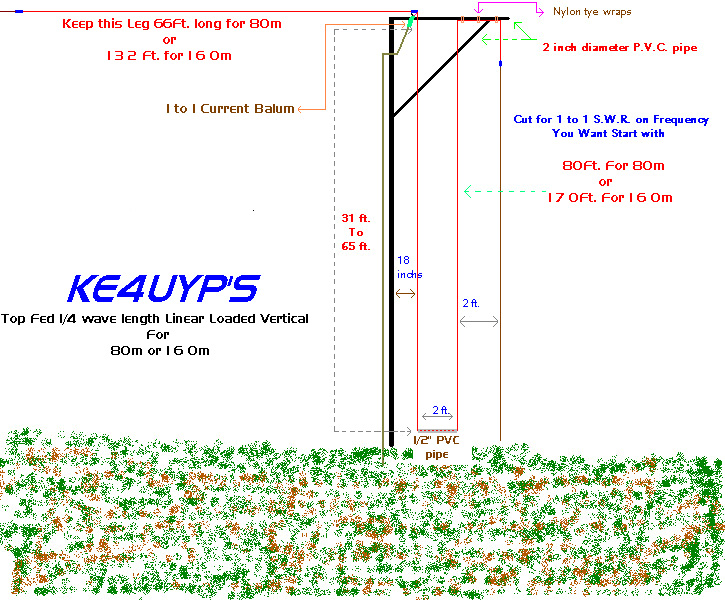 Specifications
Specifications
This is a vertically and horizontally polarized antenna the Linear loaded 1/4 wave length vertical radiator introduces very little loss. The over all radiation efficiency is high at 80% to 85%. Enhancing this vertical radiator is the 1/4 wavelength horzontally polarized radiator (counterpoise) Located at the feed-point an note it is at the top of the antenna giving you a almost Totally Omnidirectional pattern of high wave angle horzontally polarized Radiation.
gain=1DBi
300khz bandwidth under 2 two 1 SWR. on 80m
100khz bandwidth under 2 two 1 SWR. on 160m
You will be quite amazed with how well this antenna works on either 80 or 160 meters. When I designed this antenna I addressed all the pitfalls of traditional designs. Traditional low band antennas have numerous problems No. 1 most traditional verticals are based fed. This puts the majority of your power at or near ground potential. With this design all of the current is at the top of the antenna. Traditional verticals rely heavily on ground radial systems. Most verticals operate at less than 50 percent efficiency. On 20 meters and above. And less than 20 percent efficiency on 40 meters and below. Even if you have elevated ground radials most of your current is still near ground potential.
A standard half wavelength horizontal dipole operates at ninety-eight percent efficiency. If you could stand this antenna straight up where it was vertical. It would still operate at ninety-eight percent efficiency. Now of course an antenna like this would be way too tall. for most people to put up on 40 m and below. But if it was only 1/8 or 1/10 of a wavelength tall then it would be more feasible for most people. That is how my antenna design works. But of course if you only transmit a vertically polarized signal then you will not be able to talk to stations that are less than 200 miles away with good signal reports. So my design transmits both horizontal and vertical component. This gives you even illumination at all take off angles. So it makes no difference rather you are talking to someone 5 miles or 5000 miles away. Because the antenna is based upon a half wavelength dipole it does not need any ground radial system.
Because the vertical radiator is linear loaded it adds additional capacitance reactance to that element. That is why the vertical element is longer than the horizontal element. The additional wire on the vertical element ads back the missing inductance reactants to the antenna system to make it resonant. It also off centers the feed point this raises the feed point impedance back to 50 ohms. The linear loading only lowers the efficiency of the antenna about 13 percent. So with 100 watts input you get 87 Watts of effective radiated power.
The tower or mast can be metal or nonmetallic. It really does not matter. The spacing of 18 inches from a metal tower or mast Is all that is required to isolate the antenna from coupling to it. The total height of the linear loaded vertical section can be as short as 15 feet on 80 m. 25 feet is optimum. Or 32 feet on 160 m. 52 feet is optimum . The Short-ter heights will lower the efficiency a little but only just a few percent. The only significant difference is to take off the angle it is a little higher. But it is still measurably lower than a horizontal dipole at a quarter of a wavelength off the ground. So you still will see a lot of improvement on DX'ing.
When I first conceived this design my first model was on 10 meters, it was four feet off the ground at the very top, and the antenna its self was three feet tall. I made the antenna with 28 gauge wire the spacing was two inches. My first contact was to Anchorage AK I got a signal report of 5/9, my next three contacts were in to Europe Germany-5/9 +10db and Belgium 5/9 +5db .I knew then I had a winner, so then I built the first full scale model on 160 meters. It was 52 feet in length and 65 feet to the top of the antenna, the first night I went on the air I was running just 100 watts and no one would believe me, a couple of the operators insisted that I was running a amplifier.
